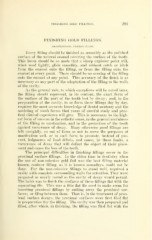Page 599 - My FlipBook
P. 599
FIKISHING GOLD l^'lLLlNCiS. 291
FINISHING (K)LD FILLINGS.
ILIJISTKATIONS: I''l(;UliKS :i7r)-:i(l8.
Every filling should be finished as smoothly as the polished
surface of the natural enamel covering the surface of the tooth.
This finish should be so made that a sharp explorer point ^v^ll,
when used lightly, glide smoothly, and without catch or hitch
from the enamel onto the filling, or from the filling onto the
enamel at every point. There should be no overlap of the filling
onto the enamel at any point. This accuracy of the finish is as
necessary as any part of the adaptation of the filling to the walls
of the cavity.
As the general rule, to which exceptions will be noted later,
the filling should represent, in its contour, the exact form of
the surface of the part of the tooth lost by decay; and, in the
preparation of the cavity, to so form these fillings day by day,
requires the most accurate knowledge of dental anatomy and the
modeling of tooth forms that years of careful study and prac-
tical clinical experience will give. This is necessary to the high-
est form of success in the esthetic sense, in the general usefulness
of the filling in mastication, and in the protection of the tooth
against recurrence of decay. Many otherwise good fillings are
left unsightly, so out of form as not to sei-ve the purposes of
mastication well, or in such form to promote, instead of pre-
vent, lodgments of food debris, and cause, by these faults, a
recurrence of decay that will defeat the object of their place-
ment and cause the loss of the teeth.
The principal difficulties in finishing fillings occur in the
proximal surface fillings. In the olden time in dentistry when
the use of non-cohesive gold foil was the best filling material
known, contour filling, as it is known nowadays, could not be
done. For the non-cohesive fillings to stand well, required a
cavitv" with comjjlete surrounding walls for retention. They were
prepared as nearly round as the cavity of decay would permit.
The habit was to finish the surfaces of these fillings flat with the
separating file. This was a thin flat file used to make room for
inserting proximal fillings by cutting away the proximal sur-
faces ; or filing between them. That is, in the treatment of prox-
imal surface decays, the proximal surfaces were first filed flat
in preparation for the filling. The cavitj' was then jirepared and
filled, after which, in finishing, the filling was filed flat with the


